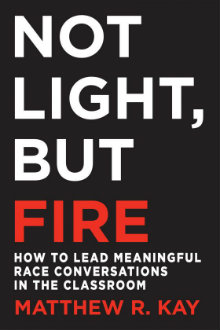How We Can Support Discussions about Race
Not Light, But Fire: How to Lead Meaningful Race Conversations in the Classroom
By Matthew R. Kay
(Stenhouse, 2018 – Learn more)

“Why don’t we have teachers of color in our building?” one of my 7th graders asked me. Even though I am a faculty member on our high school student-run Race Matters Alliance group, I was caught off guard by this question during class and not unprepared to answer it.
Conversations about racial inequity are happening: in our students’ homes, in hushed tones in our hallways, and most definitely via social media. I think Matthew Kay’s text, Not Light, But Fire: How to Lead Meaningful Conversations in the Classroom should be required reading for teachers.

Kay shares how he introduces and practices the guidelines that allow his educational space to be one where discourse can occur respectfully and productively.
By describing the infrastructure implemented in his classroom, he is generously offering us a blueprint that we can modify for our own learning spaces. Kay includes specific activities to help us move towards a classroom community where student voice is supported and made a priority. He states, “My students know that their ideas are the sacred currency of our classroom” (25). Just imagine how discussions with your students might shift if this was the way they felt.
From community to understanding
It is only after we establish and then continue to maintain a positive classroom community that we can begin to broach racial discourse with our students in a healthy and productive way.
One of the most interesting sections of the book is where Kay shares four different types of conflict. The objective being: only once we identify the kind of conflict that arises during a discussion with students can we address it, navigate through it, and grow from it.
It is in this section that he also contradicts the pervasive notion that teachers should never reveal our personal beliefs. He explains that when students inquire as to where we fall on an issue, we should feel compelled to respond, because otherwise it is “dismissive of their voices” (162).
Asking our students to be vulnerable and engage with the complexities of an issue and then not being willing to do it ourselves demonstrates a lack of investment on our part, Kay believes. And I agree. He asserts that “our students should be talking about race all year, as part of a curriculum that views race relations as human issues and as one of our most powerful and relevant analytical lenses” (91-2).
Race and gender impact students’ daily lives so it seems irresponsible if their educational experience doesn’t explore these issues.
In part two of this text, Kay delves into a chapter I think every teacher should read (twice over). The N-word has become a too-often tangled disaster in classrooms. Students and teachers alike will encounter it in a text and then balk as to how it should be handled. Kay offers questions to launch the conversation in your classroom in order to elicit deeper reflection.
Using reconstructed dialogue from his own classes, Kay shares both successes and failures so that we may be aware of the promise and the pitfalls. Later Kay also addresses how teachers can successfully stray from our plans and introduce what he calls “pop-up conversations,” which are topics that students are following outside of our curriculum.
A call for bravery
I think, ultimately, Kay is asking us to be braver. If the only topics in our classrooms are safe and sanitized ones, then we are less likely to have relevant discussions with engaged students. Not Light, But Fire is smart, supportive, and necessary.
Nicole Warchol has been teaching middle school for more than a decade. She is a former NCTE Lead Ambassador and current executive board member for the New Jersey Council of Teachers of English. She is an Aquarius and so from birth she was destined to contain multitudes. Nicole is also a Ravenclaw who on occasion writes poetry and does yoga with puppies. She tweets @MsNWarchol.


































